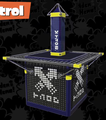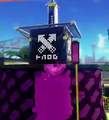Tower Control
| “ | Ride the tower! | ” |
— Objective quote seen before battle in Splatoon 2
| ||
Tower Control is one of the four Ranked Battle modes in Splatoon and Splatoon 2, alongside Splat Zones, Rainmaker, and Clam Blitz.
Tower Control was unveiled during the 7 May 2015 Splatoon-themed Nintendo Direct. The release date of Tower Control was revealed on 30 June 2015.[1]
It was added to Splatoon on 2 July 2015 at 02:00 UTC.
Appearance
The tower is a large blue cube with a stake on top, and a grate that creates an overhang surrounding the entire top surface. Its walls and ground can be inked, but the post and the grate can not. The height of the tower will also vary depending on the map, it comes in sizes: short, medium, and tall.
Gameplay
In Tower Control, two teams of four players fight to control a central tower that moves through the stage along a predetermined path. The path is mirrored and goes towards each side of the team's territory. The tower starts at the center, and when a player rides on top of it, it begins moving towards the enemy territory, the bottom path marking becomes the team's color and flows to the end of the path towards the finish mark. If an enemy player is standing on the tower while the player rides it, the tower is contested and stops moving. If the player standing on the tower falls off the platform or gets splatted, after an enemy player stands on the tower or 5 seconds have passed, the tower will begin moving rapidly back to its initial position. Because of this gameplay element, the player on the tower is a constant target and must be defended by teammates on the ground. The match will end when one team rides the tower all the way to the opponent's finish mark, or after five minutes are up and overtime is done, the team who pushed the furthest wins. Overtime in this mode begins if the current losing team has control of the tower when the five minutes are up and finishes once that team loses control of the tower or takes the lead. A draw can not happen and the game will degrade a point for the team who reached second to the score.
Splatoon
In Splatoon, the more players are riding, the faster it goes. The changes in speed are as follows:[2]
| Inklings | 1 | 2 | 3 | 4 |
|---|---|---|---|---|
| Speed | 1.00× | 1.20× | 1.33× | 1.43× |
Splatoon 2
Tower Control received a few tweaks in Splatoon 2. Checkpoints have been added along the path the tower takes. When the tower reaches a checkpoint, it will stop for a set period of time before continuing on as normal.[3] Once a checkpoint is cleared, the tower will be able to pass through it again without stopping. If the tower reached a checkpoint and was interrupted, whether by enemy team interaction or 5 seconds have passed since the team left the tower, after 3 seconds of lost control, the checkpoint's timer will refill. If the pushing team gained control back, the 3 seconds tick is reset and the checkpoint will continue to be cleared.
In Splatoon 2, the tower no longer gains a general speed boost from having multiple players ride it. Instead, the number of players only affects the speed rate checkpoints are cleared. Template:Todo
Octo Expansion
Tower Control appears as two of the tests in the Octo Expansion: Rad Ride Station at Snapper Canal and Sweet Ride Station at Starfish Mainstage. Both tests require Agent 8 to ride the tower past six checkpoints and against multiple Sanitized Octolings. At the last checkpoint, a Sanitized Octoling will Super Jump onto the tower with a Splashdown and throw a Splash Wall down to try to get Agent 8 off the tower. Agent 8 has unlimited lives and can only fail the test if five minutes run out.
Unlike multiplayer, a Launchpad will appear near the players spawn point, which will Super Jump Agent 8 directly onto the tower. If Agent 8 is splatted, only one Sanitized Octoling will take the tower.
In the Octo Expansion, the logo on the side of the tower is replaced by the Kamabo Corporation logo.
Visuals
To help identify the tower's current position, a pillar made of rings of light shines from its position into the sky. Players can look up and around in order to locate the tower. The two goal spots and checkpoints have glowing lights from them.
While the tower is moving, its path will be shown around the stage, letting players know where it will go. The path will lightly glow with the ink of the team that is currently in possession and the glow will follow the path that the tower is taking.
When not on the tower, the anchor Ranked Battle icon, seen throughout the stage is pointing towards the position of the tower. On the map, that icon is always visible. path, goal, and checkpoints are not visible on the map.
Victory
The score is measured by how far into enemy territory a team has ridden the tower.
If a team manages to get the tower to the enemy goal spot, then that team will win the match, and achieve a Knockout score. The other team will get no points.
If the game timer runs out with the tower in a neutral state, the team that managed to reach the closest to their goal at any point during the match will win. If the game timer runs out and the tower is being controlled by the losing team, then the game will go into overtime until that team manages to takes the lead or until the status of the tower changes to either neutral or the winning team's control.[4]
Overtime rules
Overtime will begin if the losing team (with a shorter distance traveled, or reaching the same distance point later than opposition) currently has control of the Tower. At this point, Overtime will end when:
- The losing team reaches a farther distance with the Tower than the winning team, thereby giving the losing team the victory.
- The winning team regains control of the Tower.
- It should be noted that all the winning team needs to do to retake control of the Tower is to have more of their team on the Tower than the losing team, or have one of the winning team's players on the tower if none of the losing players are on it.
- The losing team loses control of the Tower.
- This is marked by the indicator turning from the losing team's color to the neutral Ranked Battle symbol, and happens five seconds after the Tower being empty.
In-game info
| “ | The objective of Tower Control is to ride the tower into the enemy's base. So when the match begins, make a beeline for the tower! The tower will start moving automatically once you climb aboard. Riding the tower makes you an easy target, though, so watch out! If the tower sits idle for too long without anyone riding it, it'll return to its starting position. As the tower approaches the goal, your goal distance will decrease. If the battle ends without either team reaching the goal, the team with the lowest goal distance will win! In this ranked battle, Battle Points are awarded based on goal distance. Riding the tower by yourself is pretty tough, so be sure to work as a team. Knowing when to bail off the tower, using each stage's features to your advantage, and supporting your teammates are the keys to victory! | ” |
— Splatoon in-game info
| ||
Audio
Being ridden by Team Alpha:
Being ridden by Team Bravo:
- When riding the tower, it will play gentle music similar to an ice cream truck's tones.
- It also resembles Calamari Inkantation
- A modified version of this music can be heard under a platform after the final checkpoint of the Octo Valley mission Inkrail Skyscape.
- In the Octo Expansion, this tune is replaced by a rendition of Completion.
Trivia
- Tower Control bears a strong resemblance to Team Fortress 2's Payload and Payload Race modes, where a team pushes a cart to the enemy base in order to win the match. Some maps include a custom version that functions identically to Tower Control, with a cart that can be pushed by both sides.
Gallery
Splatoon
-
Promotional image for Tower Control.
-
Artwork
-
-
-
-
-
-
-
-
-
-
Splatoon 2
-
-
-
Artwork
-
Mode icon
-
The tower's end goal at Inkblot Art Academy
-
The end goal is still visible when covered with ink
-
The tower's Mem cake.
Names in other languages
References
|
|














